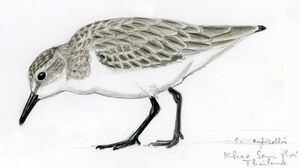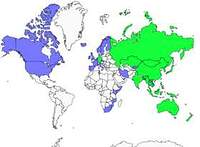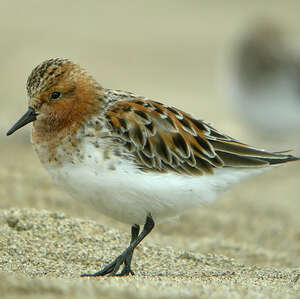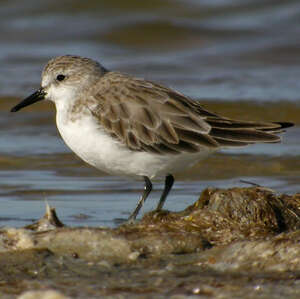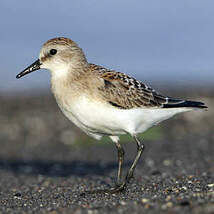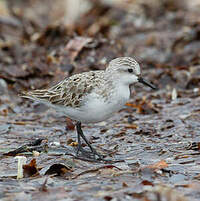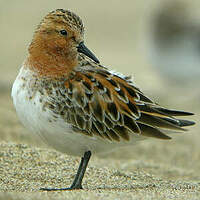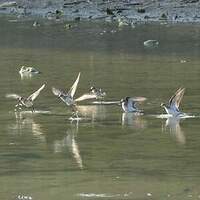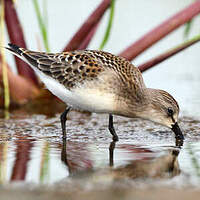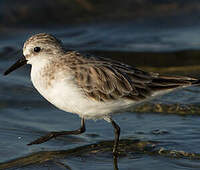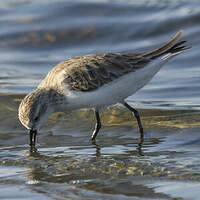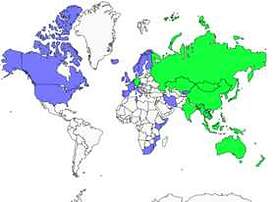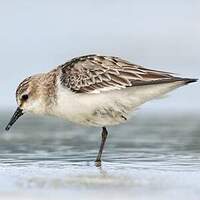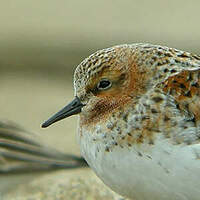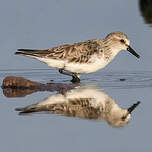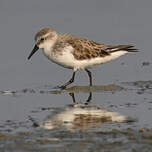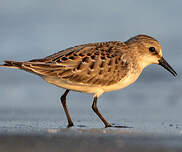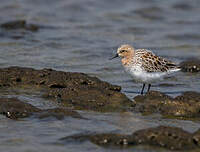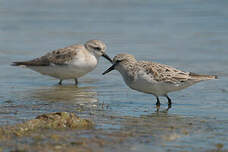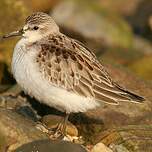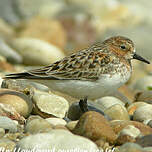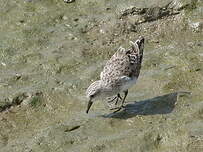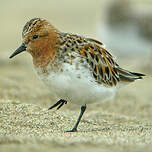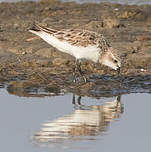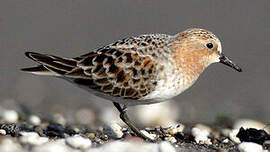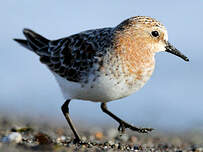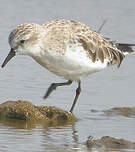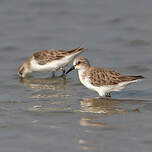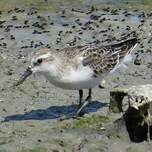Red-necked Stint
Calidris ruficollis - Bécasseau à cou roux Bécasseau à col roux
Identification
The Red-necked Stint is a small sandpiper close to the Little Stint. It is unmistakable in nuptial plumage with its intense red cheeks, neck and breast. The upper part feathers (back, scapulars, upper coverts) are black largely bordered with red. Both young and adults out of the breeding season have almost similar plumage. Dark grey on top (with the feathers bordered with brown in young ones), white underneath. A brownish spot at the side of the chest, barely marked with slight black (grey and barely visible in young ones) spots. The upper part of the head has a finely rayed, long white eyebrow that widens at the base of the beak. The beak is short, black and straight, somewhat wider at the tip. Can easily be confused with almost all little sandpipers with black legs (Little Stint, Semipalmated Sandpiper, Baird's Sandpiper). Young birds on coast are very difficult to differentiate from the Young Little Stint.
In flight, this sandpiper is highly contrasted (dark on top, light underneath); the very dark primary coverts create a characteristic spot on the wrist of adult in winter plumage. This spot contrasts with the clear base of the primary remiges. This wing design is only seen in the much larger Sanderling.
Subspecific information monotypic species
Foreign names
- Bécasseau à cou roux,
- Correlimos cuellirrojo,
- pilrito-de-pescoço-ruivo,
- Rotkehl-Strandläufer,
- rozsdástorkú partfutó,
- Roodkeelstrandloper,
- Gambecchio collorosso,
- rödhalsad snäppa,
- Rødstrupesnipe,
- pobrežník červenokrký,
- jespák rudokrký,
- Rødhalset Ryle,
- rusokaulasirri,
- Rooinekstrandloper,
- territ de gola roja,
- Roðatíta,
- biegus rdzawoszyi,
- sarkankakla šņibītis,
- rdečevrati prodnik,
- Песочник-красношейка,
- Kedidi leher-merah,
- トウネン,
- 红颈滨鹬,
- นกสติ๊นท์คอแดง,
- 紅胸濱鷸〔穉鷸、紅頸濱鷸〕,
Voice song and call
Habitat
Behaviour character trait
Flight
Dietfeeding habits
Most of the food is taken directly from the ground, however, like the Red-necked Stint, it can be taken from the mud up to a depth of about 2cm. The main diet consists of invertebrates, with some seeds added. On breeding sites, mainly terrestrial invertebrates are eaten, while in migration and wintering, the basis of the diet consists of aquatic invertebrates.
Reproduction nesting
These birds are monogamous. The nest, made of vegetal debris, is placed in a depression of the ground dug out by the male.
The laying is generally of 4 eggs, incubated by both sexes. The incubation lasts about three weeks and the female starts its migration towards the south one or two days later. The male accompanies the young (who feed themselves) until their flight, at the age of 17 days. There is only one laying, but the female can make a replacement laying if the first one is destroyed early.Geographic range
The Red-necked Stint breeds in the Far East of Russia in a narrow range extending from the Taymyr Peninsula to the north of Kamchatka. It occasionally nests in northern Alaska. It is an over-wintering bird from India to New Zealand (southern China, Papua New Guinea, Indonesia, Indo-China).
It is abundant in Australia during the northern winter and a large number remain there during the southern winter. Its migration takes place along both Asian coastlines and inland (regularly in Kazakhstan, for example). Its distribution and its migration pattern explain why the species is very rare in Europe where there have only been 15 observed sightings. An adult was present in the Pas-de-Calais from the 15th to 21st July 1994. It was also seen in Belgium on 16th August 1988. At least six sightings have been recorded in Great Britain.
Threats - protection
IUCN conservation status
concern
in the Wild
threatened
evaluated
This non-threatened species has a global population of around 315,000 individuals. On wintering spots, a decrease in population has been observed in Japan, whereas numbers have increased in Australia, suggesting a shift in the distribution of the Red-necked Stints.
Sources of information
- IOC World Bird List (v14.2), Gill, F and D Donsker (Eds). 2024-04-18.
- Guide des limicoles d'Europe, d'Asie et d'Amérique du Nord, D. Taylor
- Le guide ornitho : Le guide le plus complet des oiseaux d'Europe, d'Afrique du Nord et du Moyen-Orient : 900 espèces, Svensson, Mullarney, Zetterstrom
- Limicoles, gangas et pigeons d'Europe, Paul Géroudet (mise à jour Georges Olioso)
- Nouvel inventaire des oiseaux de France, Philippe J. Dubois, Pierre Le Maréchal, Georges Olioso, Pierre Yésou
- The Field Guide to the Birds of Australia, Graham Pizzey et Frank Knight
- Vol. 3 - Handbook of the Birds of the World, Josep del Hoyo-Andrew Elliott-Jordi Sargatal
- Waterbird Population Estimates, Simon Delany Derek Scott
- Avibase, Lepage Denis
- The Birds of North America,
Other sources of interest
 Specification sheet created on
29/07/2023 by Georges Olioso
Specification sheet created on
29/07/2023 by Georges OliosoTranslation by AI Oiseaux.net
© 1996-2025 Oiseaux.net
- Accipitriformes
- Aegotheliformes
- Anseriformes
- Apodiformes
- Apterygiformes
- Bucerotiformes
- Caprimulgiformes
- Cariamiformes
- Casuariiformes
- Charadriiformes
- Ciconiiformes
- Coliiformes
- Columbiformes
- Coraciiformes
- Cuculiformes
- Eurypygiformes
- Falconiformes
- Galliformes
- Gaviiformes
- Gruiformes
- Leptosomiformes
- Mesitornithiformes
- Musophagiformes
- Nyctibiiformes
- Opisthocomiformes
- Otidiformes
- Passeriformes
- Pelecaniformes
- Phaethontiformes
- Phoenicopteriformes
- Piciformes
- Podargiformes
- Podicipediformes
- Procellariiformes
- Psittaciformes
- Pterocliformes
- Rheiformes
- Sphenisciformes
- Steatornithiformes
- Strigiformes
- Struthioniformes
- Suliformes
- Tinamiformes
- Trogoniformes

